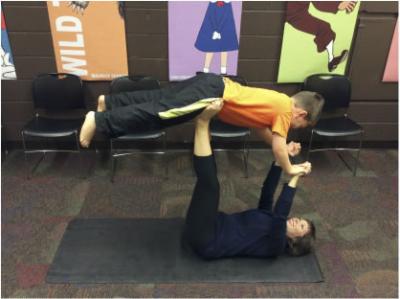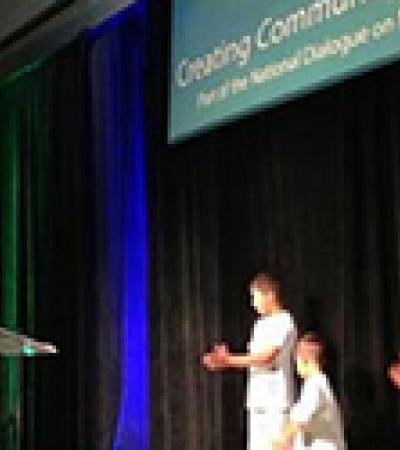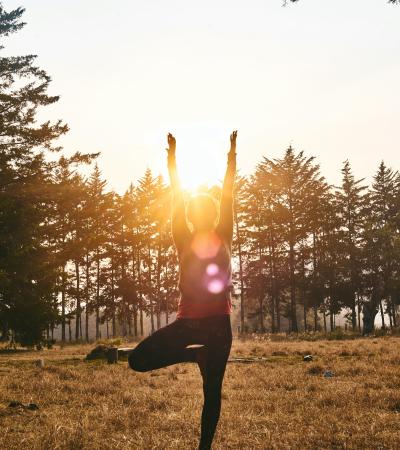Sometimes when I am training librarians, teachers and staff on how to start yoga programs in their schools and libraries, I see a look of fear and panic creep into their otherwise eager-to-help faces. That’s when my empathy kicks in and I think back to when I was first learning how to teach yoga to children and was completely overwhelmed. I was nervous about sequencing the poses, terrified that someone would get hurt and, if I’m honest, most afraid I would look like an idiot and no one would want to come back to my class. I’m here to tell you, after years of practice and trial and error, that classes get smoother and feel more natural, but those first few wonky months of planning programs and simultaneously praying that people will and won’t show up are tough.
When Leah Kalish, the CEO and founder of Move with Me Yoga Adventures, trained me in how to teach yoga to children, my literal “beginner’s mind” was clouded with fear and self-judgment instead of openness to the experience. Leah reassured me that I was a natural teacher and that the kids were in good hands, but her generous confidence in me only made my self-doubt worse (“She doesn’t know the real me, the one who makes a fool of myself!”). Like anything I do, I jumped off the plank, floundered around for a bit, and then started out to sea, choppy waters be damned.
I’ve tried my best to figure out ways to put new yoga teachers and administration at ease beyond my well-intentioned pep talks, carefully designed program curriculum and fancy metrics. So the last time I taught a webinar I invited videographer Dale Strickland to record one of my children’s yoga classes at the Fredericton (N.B.) Public Library. It wasn’t scripted and there were no actors; it was just me teaching in my usual way with a few local kids. We edited the video down from 45 minutes to 20 so you can get a good idea of how the class is structured without being subjected to the whole thing.
My hope is that this video will help newbie teachers see that not everything in the class needs to go perfectly. It doesn’t look like a commercial yoga-for-kids DVD. My teeth aren’t bleached and there are no ocean waves in the background. It is a raw look at what a real class looks like, silly jokes and interruptions included. The important thing is that the kids have fun, and you can see that they did in the video by their smiles and how calm they are at the end.
I’m still learning. I teach a weekly Afterschool Yoga Family Fun Time! at the L.P. Fisher Public Library in Woodstock, N.B.. Everyone is welcome and every event is a different mix of 10 to 15 people. I get attendees such as arthritic grandparents, breastfeeding moms, snarky middle-schoolers, distracted toddlers, climbing preschoolers and everything in between. When you are teaching all different ages, abilities and attention spans, you have no choice but to stay on your toes!
My only non-negotiable structure is calm belly breathing at the beginning and end of every lesson, with alternating poses and games in between. We always finish with a story and coloring sheet or craft. It is what I like to think of as finely controlled chaos. Everyone has a good time. They keep coming back and bringing more people, so the yoga must be working its magic.
Here are a few tips to help remind you to be gentle, patient and persistent with yourself (and your students!):
- Image

Keep a sense of humor and be prepared to change the lesson's structure to make sure your students are learning and having fun. Keep your expectations low. If you maintain the simple goals of everyone having fun and no one getting hurt, then you won’t cry in the savasana pose while three kids fight over who gets to ring the meditation bell and a baby crawls over your face and drools on your nose and his mom talks loudly on her cellphone (been there!).
- Have a sense of humor. You are teaching children after all (see above).
- Prepare for class with a solid curriculum, but also be prepared to totally change or abandon those plans. Find a good fingerplay, song or couple of poses that you can remember and are well-liked to use when you’re a pinch.
- Know that sometimes no one will be paying attention to anything you are saying. Just keep moving and they’ll catch up. Don’t take it personally.
- Use your body and voice to maintain a modicum of control over the chaos. When your students get loud and unruly, get very soft and quiet and move slowly. They will calm down. When they get slow and lethargic and look bored, get louder and more animated and rhythmic. It works (almost) every time.
- Don’t worry too much about posture and alignment. They are kids; let them experiment with their bodies — unless of course they have major medical or developmental issues, but that’s a topic for another day. Your students will mostly self-regulate, and sometimes they will try to show-off. When I see that — or hear a few “ows!” or “I can’t do this. It’s too hard!” — I gently remind them to listen to their bodies and only do what feels good for them and not worry about what others are doing on their mats. I give them an alternative restorative pose (such as child’s pose) to do instead. Don’t worry about teaching them to relax their piriformis while engaging their pelvic lock. Instead, work on getting them to tell their right from their left.
- Give them the gift of space, time and attention. I always add a coloring page after the storytime (mandalas are great for this). Then I just color with them and listen to them talk and tell stories. There is gold here. So many kids (adults too!) are in desperate need of just one person in their day to genuinely listen and be present for them. Give them this gift. It is really a gift for yourself. Let’s take care of each other.
If after watching this video of me goofing around with some kids you are still worried you can’t pull it off, feel free to email me and I’ll do my best to chill you right out. You got this!



